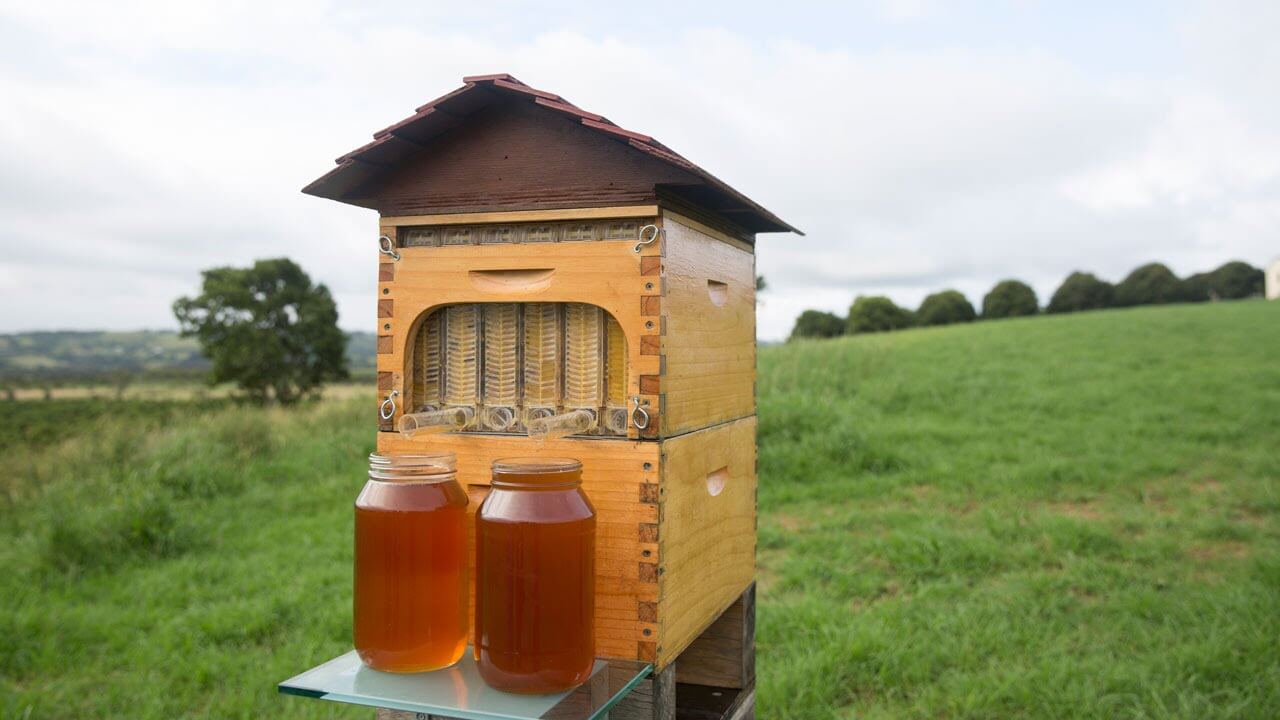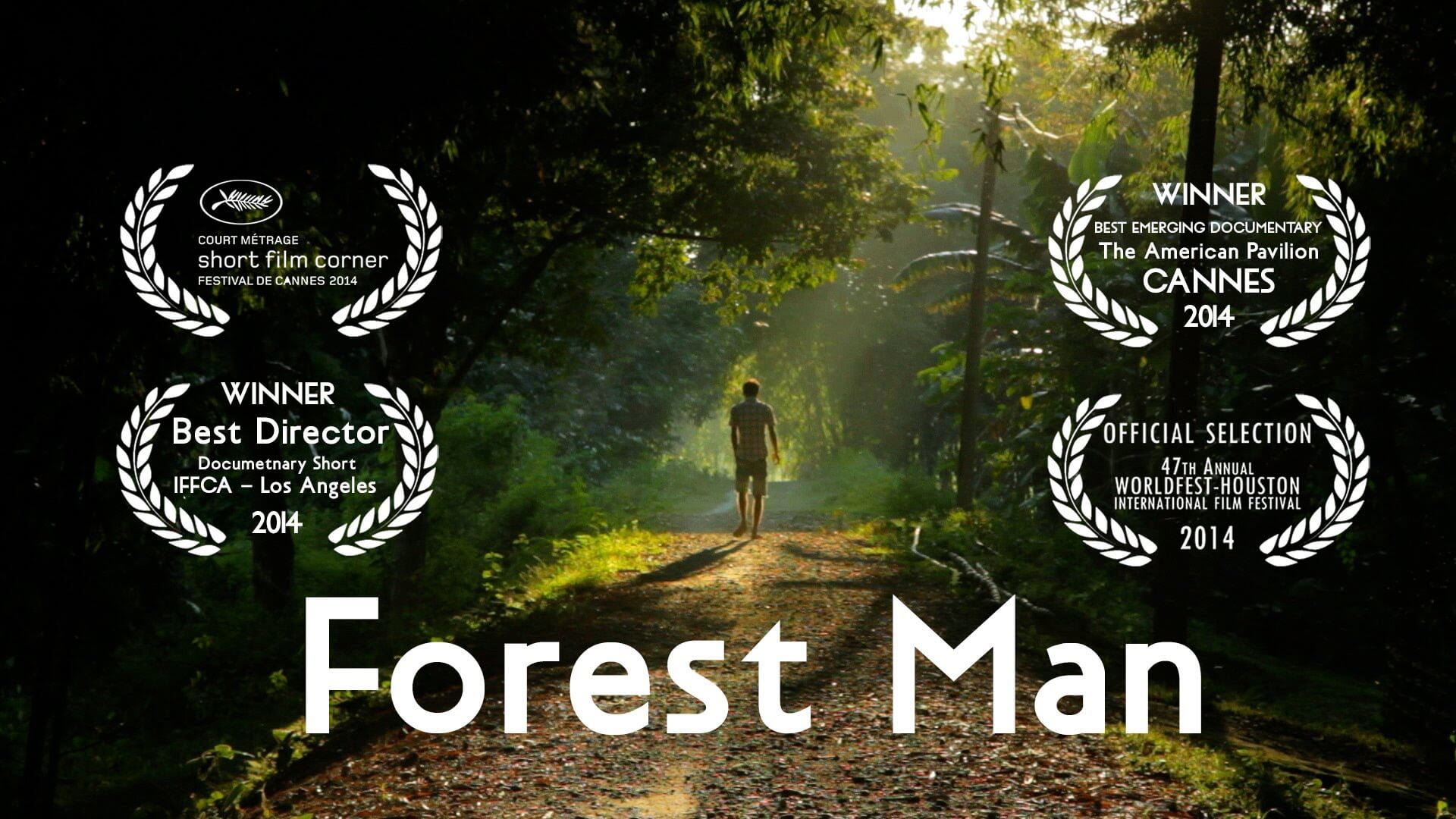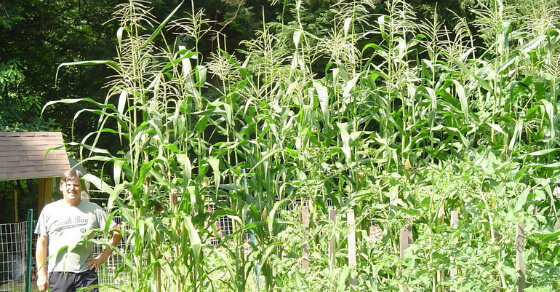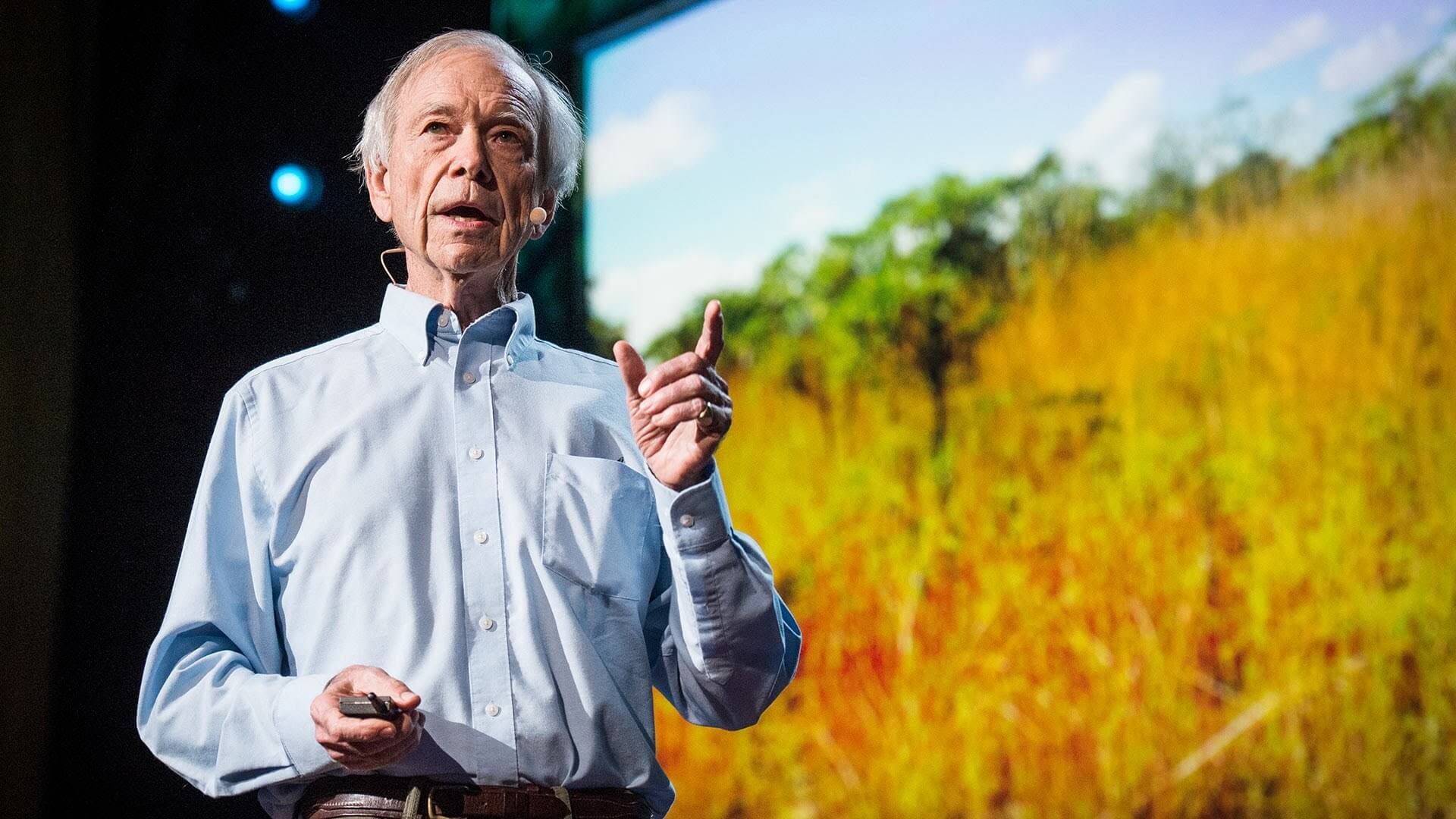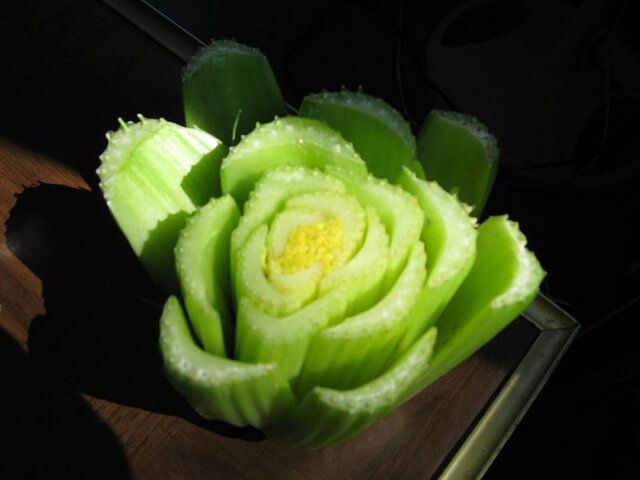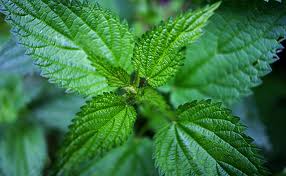Microbes Will Feed the World, or Why Real Farmers Grow Soil, Not Crops – Modern Farmer

Out on the horizon of agriculture’s future, an army 40,000 strong is marching towards a shimmering goal. They see the potential for a global food system where pesticides, herbicides and fertilizers are but relics of a faded age.
They are not farmers, but they are working in the name of farmers everywhere. Under their white lab coats their hearts beat with a mission to unlock the secrets of the soil – making the work of farmers a little lighter, increasing the productivity of every field and reducing the costly inputs that stretch farmers’ profits as thin as a wire.
‘Producing more food with fewer resources may seem too good to be true, but the world’s farmers have trillions of potential partners that can help achieve that ambitious goal. Those partners are microbes.’
The American Society of Microbiologists (ASM) recently released a treasure trove of their latest research and is eager to get it into the hands of farmers. Acknowledging that farmers will need to produce 70 to 100 percent more food to feed the projected 9 billion humans that will inhabit the earth by 2050, they remain refreshingly optimistic in their work. The introduction to their latest report states:
“Producing more food with fewer resources may seem too good to be true, but the world’s farmers have trillions of potential partners that can help achieve that ambitious goal. Those partners are microbes.”
Mingling with Microbes
Linda Kinkel of the University of Minnesota’s Department of Plant Pathology was one of the delegates at ASM’s colloquium in December 2012, where innovators from science, agribusiness and the USDA spent two days sharing their research and discussing solutions to the most pressing problems in agriculture.
“We understand only a fraction of what microbes do to aid in plant growth,” she says. “But the technical capacity to categorize the vast unknown community [of microorganisms] has improved rapidly in the last couple of years.”
Microbiologists have thoroughly documented instances where bacteria, fungi, nematodes – even viruses – have formed mutually beneficial associations with food plants, improving their ability to absorb nutrients and resist drought, disease and pests. Microbes can enable plants to better tolerate extreme temperature fluctuations, saline soils and other challenges of a changing climate. There is even evidence that microbes contribute to the finely-tuned flavors of top-quality produce, a phenomenon observed in strawberries in particular.
“But we’re only at the tip of the iceberg,” says Kinkel.
In the Field
Statements such as, “There are 10 to the 6th fungal organisms in a gram of soil!” and, “This bacterial biofilm has tremendous communication properties!” are breakroom banter among microbiologists, but what does it all mean for farmers? The answers reach back into the millennial past of agriculture, back to the dawn of life on earth.
Whenever a seed germinates in the wild or a crop is planted by a farmer, the microbial community that helps that species to grow and thrive is mobilized. Chemical signals enter the soil via the exudates of the plant and a symphony of underground activity commences. Genetic information is exchanged; the various microbial players assume their positions on the tissues of the plant; often, one microbe colonizes another, providing a service that helps the first microbe to assist the plant whose roots it is embedded in.
Though this elaborate dance takes place without any input from humans, we have been tinkering with it for a long time.
For example, the process of nitrogen fixation in plants of the legume family (which includes beans, peas, peanuts and many other crop plants) is one of the little bacterial miracles that makes our planet habitable. Anyone who has ever observed the roots of a legume knows that they are covered in strange white or pinkish growths, about the size of ants, which appear to be an infection of some sort. Undoubtedly, ancient farmers had an intuitive understanding that these warty protuberances had something to do with the noticeable ability of legumes to improve the soil, but it wasn’t until the late 19th century that the mystery began to unfold.
While Louis Pasteur was discovering how to preserve milk and becoming famous as the father of microbiology, a relatively unknown colleague of his with a penchant for plants was making another discovery, of perhaps even greater historical importance. In 1888, Martinus Beijerinck, discovered that tiny bacteria called Rhizobia infect the roots of legumes, causing the swollen nodules. Rather than an infection that weakens the plant, the nodules are the fertilizer factories of the plant kingdom, disassembling atmospheric nitrogen – which plants are unable to use – and refashioning it in a soluble, plant-friendly form.
Rhizobia are key ingredients of the earth’s verdancy and harnessing the bacteria to improve soil fertility has long been one of the cornerstones of sustainable agriculture. Yet, modern day microbiologists are now aware of scores of other equally profound plant-microbe interactions, discoveries they believe will have a big impact as human populations continue to soar on a planet of finite resources.
Making the Translation
In her lab at the university, Kinkel experiments with antibiotic bacteria that suppress plant pathogens and tests various soil management strategies to see their effects on microbial communities. In Colombia, microbiologists have learned to propagate a fungus that colonizes cassava plants and increases yields up to 20 percent. Its hyphae – the tiny tentacles of fungi – extend far beyond the roots of the cassava to unlock phosphorus, nitrogen and sulfur in the soil and siphon it back to their host, like an IV of liquid fertilizer.
In Colombia, microbiologists have learned to propagate a fungus that colonizes cassava plants and increases yields up to 20 percent
Though microbiologists can coerce soil to produce extraordinary plant growth in their labs and test plots, transferring the results to everyday agricultural practices is not a straightforward process.
“Connections to farmers are a weak link,” Kinkel laments, alluding to a “snake oil effect” where farmers have become leery of salesmen hawking microbial growth enhancers that don’t pan out in the field. “The challenge of [these] inoculants,” she says, “is they may not translate in all environments.”
Though researchers continue to develop promising new microbial cocktails, there is an increased focus on guiding farmers to better steward the populations that already exist in their soil. Kinkel is working on an approach she believes will help farmers sustain optimal microbial communities by ensuring they have the food they need – carbon – at all times. She calls it ‘slow release carbon’, but it’s not something farmers will see in supply catalogs anytime soon. Kinkel says she has access to resources for her academic research, but lacks a “deliberate pipeline for product development.”
It Takes a Global Village
The 26 experts from around the world convened at the ASM colloquium concluded their discussions with a bold goal for the future of agriculture: They’ve challenged themselves to bring about a 20 percent increase in global food production and a 20 percent decrease in fertilizer and pesticide use over the next 20 years.
With an indomitable belief that science will do its part to make this dream a reality, the scientists are looking to their corporate and regulatory counterparts to build a pipeline of information to farmers. They’re hoping that top-down investments in research and technology will meet directly with grassroots changes in the culture of farming – without all the snake oil-vending agribusiness interests in the middle. Ultimately, they envision a future where farmers again trust in the unseen forces of the soil – instead of the fertilizer shed – for answers to their challenges.
Your Pee is an Excellent Fertilizer. Here’s How & Why You Should Use It
Modern synthetic fertilizer consists of varying amounts of nitrogen (N), phosphorus (P) and potassium (K), which are added to croplands to replace these depleted nutrients in the soil. There are several problems with this method, one of the primary ones being that these are finite resources.
Nitrogen, for instance, must be captured through a process that requires natural gas. And, unlike nitrogen, phosphorus and potassium cannot be synthesized, and our aggressive large-scale farming methods, which deplete soils of nutrients that then must be replaced, are quickly burning through available phosphorus and potassium stores.
We’re now hearing discussions of “peak phosphorus and potassium” in the way we discuss “peak oil,” and, according to some, we may soon be facing looming shortages of these two critical fertilizer ingredients. According to well-known investor Jeremy Grantham, writing for Nature:
“These two elements cannot be made, cannot be substituted, are necessary to grow all life forms, and are mined and depleted. It’s a scary set of statements. Former Soviet states and Canada have more than 70 percent of the potash [potassium]. Morocco has 85 percent of all high-grade phosphates [phosphorous]. It is the most important quasi-monopoly in economic history. What happens when these fertilizers run out is a question I can’t get satisfactorily answered and, believe me, I have tried. There seems to be only one conclusion: their use must be drastically reduced in the next 20-40 years or we will begin to starve.”
Urine May Represent the Future of Fertilizer
Human urine is naturally rich in nitrogen, potassium, and phosphorus, and with about 30 billion gallons produced every year in the US alone, it’s certainly in abundant supply. For the average person, a year’s worth of urine contains about eight pounds of nitrogen and nearly one pound of phosphorus – that’s enough to grow about one year’s worth of food!
I am in complete agreement with this concept and for the last year have been collecting all my urine and putting it in the that I feed my fruit trees, vegetables, herbs, and aloe. It works wonderfully with , as the nitrogen in the urine helps balance the carbon in the biochar.
According to the Rich Earth Institute, which is running an experiment in nutrient reclamation, using source-separated urine as a fertilizer, getting urine out of wastewater and into agriculture will not only help reduce pollution but also represents a viable natural fertilizer for the future. They state:
“The average person flushes the toilet five times a day, and four of those times are just for urine. This means that 80% of our flushwater-or over 4,000 gallons of clean water each year per person-is used just to get rid of urine! That is a lot of clean water used to transport ‘liquid gold’ into the sewer, where it becomes pollution. If we save it instead of flushing it, we can harvest a valuable resource that we can use in agriculture.“
The Rich Earth Institute experiment is the first legally authorized community-scale “urine reuse” project in the US, but field trials involving urine fertilizer are already underway in many other countries, including Europe, Africa, and Asia.
As for the “yuck factor,” human urine isn’t nearly as “gross” as it seems, since it’s virtually sterile when it leaves your body. Just to be sure (since urine can become contaminated by fecal particles), the Rich Earth Institute “pasteurizes” collected urine in solar heaters prior to sprinkling it on crops. The first experiment, conducted in 2012 on a hayfield, yielded impressive results…
-Urine-treated hay was darker green in color and more lush than control plots
-Hay treated with the most urine (100 pounds of nitrogen/acre) yielded 5.8 times as much hay as the control plot
-Hay treated with the mid-level amount of urine (50 pounds of nitrogen/acre) yielded 3.8 times as much hay as the control plot
In 2013, the field trial was expanded, both in the number of volunteers donating urine and the scope of the field trials. The group began testing for optimal dilution rates of urine when applied to hay and they’re now working with the US Environmental Protection Agency (EPA) testing the use of urine fertilizer on vegetables.
The idea seems to be catching on quickly, as they now have three additional farms using urine fertilizer, along with a waiting list that’s only hindered by how much urine they can collect. Ultimately, they’re hoping to create “peecycling” programs that other cities and states can copy, but this will require some major changes to regional and national policy and wastewater treatment facilities.
Urine Plus Ash Makes Beets Grow Nearly 30 Percent Larger Than Conventional Fertilizer
Separate studies have also shown promise in using urine as fertilizer. In one experiment, researchers compared beets grown in four different ways: one with conventional mineral fertilizer, another with urine, a third with urine and wood ash, and a final control group grown with no fertilizer.
The beets fertilized with urine were 10 percent larger, and those fertilized with urine/ash were 27 percent larger than those grown in mineral fertilizer. As for nutrient content, all the beets were similar, and in a blind taste test the beets were rated as equally flavorful.
The researchers concluded that urine is a perfectly viable source of fertilizer, and one that is readily available and sustainable (the average American urinates 500 liters a year). Urine has also been used to fertilize cabbage, tomatoes, sweet peppers, and cucumbers, with similar favorable results, and it’s free – unlike synthetic fertilizers that some farmers around the world can scarcely afford.
Setbacks to Widespread Use of Urine Fertilizer
There are some issues that must be overcome before urine fertilizer can become “mainstream.” Although urine is technically sterile, it does contain traces of pharmaceuticals, which are not removed at wastewater treatment plants. The Rich Earth Institute is currently working with the EPA to track how the soil is absorbing these types of contaminants from urine fertilizer.
“When we use flush toilets that are connected to sewers, these residual drugs pass largely unchanged through the treatment plant in about twenty-four hours and then go directly into rivers, lakes, or the ocean, where they can harm sensitive aquatic life and end up in our drinking water. If we spread the urine on agricultural land instead, the robust soil ecosystem has a chance to break down the drugs and biodegrade them over a much longer period of time, greatly reducing or eliminating their levels before they ever reach a body of water. In this way, soil application is a great improvement over current practice.”
So far, research suggests that any residual hormones or pharmaceuticals are likely to be negligible and basically non-existent in urine-fertilized crops. In fact, there may be benefits to spreading such urine contaminants on land, as opposed to depositing them in waterways, as is currently done. The Rich Earth Institute explained:
“Using specially designed toilets that collect urine separately from feces, urine can be collected in a storage tank instead of being flushed down the drain. After being sanitized, it can be used as a high-nitrogen liquid fertilizer, taking the place of chemical fertilizers. This system is more efficient than sewer-based sanitation at getting all the nutrients from the urine to the farm, because the source-separated urine is directly collected and transported. In municipal wastewater, the nutrients in the urine are incredibly dilute, and so it is very challenging to extract them again. In fact, many treatment plants let most of the nitrogen and phosphorus pass through untreated. Some do capture the phosphorus, but most which treat for nitrogen drive it off as a gas, rather than capturing it as fertilizer.”
Another issue is the fact that sewage systems would have to be radically redesigned to separate liquid waste from solid, a practice that requires the use of separating toilets that have a divided bowl and independent pipes to keep the urine separate. There are other benefits to using separating toilets as well, such as less water usage and less energy requirements in sewage treatment. However, neither the toilets, nor the sewage systems, are in widespread use in the US. As reported by the Rich Earth Institute:
However there is nothing that is preventing you and your family from implementing this system now. If you have a garden, it is relatively easy to collect your urine and apply it to the garden. This will present less of a burden on your water filtration facility, but, more importantly, it puts the nutrients where they belong, back in the soil, not in the water system. It is easy to collect the urine in one-quart wide mouth Ball jars and then transfer them to larger 2.5-gallon containers if you need to. Just be careful to dilute it about 5:1 before you apply it to the soil that surrounds the plants you want to nourish.
Biological Agriculture Is the Future of Food
The use of urine as fertilizer is a major improvement over chemical fertilizers. However, according to , an internationally recognized expert on the benefits of sustainable soil science, the real nutrition your plants require is actually derived from microorganisms in the soil. These organisms take the mineral material that’s in your soil and convert it into a plant-available form. Without these bioorganisms, your plants cannot get the nutrients they need. So what you need is not more soil additives; what you need is the proper balance of beneficial soil organisms.
According to Dr. Ingham, there’s no soil on Earth that lacks the nutrients to grow a plant. She believes the concept that your soil is deficient and needs added phosphorus or nitrogen in order to grow plants is seriously flawed, and largely orchestrated by the chemical companies, because it’s based on looking at the soluble, inorganic nutrients that are partly present in your soil.
Interestingly enough, you can use a starter culture to boost the fermentation and generation of beneficial bacteria much in the same way you can boost the probiotics in your . For compost, this strategy is used if you want to compost very rapidly. In that case, you can use a starter to inoculate the specific sets of organisms that you need to encourage in that compost. This is but one example of high-performance agriculture methods, which are a FAR superior alternative to attempts at “improving” agriculture through the use of genetic engineering and chemical fertilizers. In order for plants to flourish, the soil must first be made hospitable for beneficial microorganisms. To accomplish this, you need to:
1. Have the right nutrient balance in the soil
2. Inoculate the soil. This can be done by adding soil probiotics or basic fermentation products such as compost tea
3. Apply proper food (fertilizer) for the microorganisms to consume and thrive. The microbes in turn will then feed the proper nutrients to the plants grown in that soil. The better you’re able to fertilize the microbes, the healthier your plants will be, and the fewer plant diseases, pest infestations and weed problems you’ll have
Biological Gardening/Farming Aims to Bring Health Back to Soil
Urine fertilizer may have an important place in high-performance agriculture, but there are other exciting advancements as well, including things like humic acid or humates, which promote the proliferation of beneficial microorganisms in the soil, as well as sequester carbon in the soil.
The application of (charcoal created by slowly heating biomass such as wood and plant materials in a low-oxygen environment) to soil may also help sequester carbon for hundreds, perhaps even thousands of years, and radically improve soil fertility by serving as a substrate for beneficial soil microbes. Biochar works particularly well with urine as it captures the nitrogen like a magnet and releases it slowly to the microbial community that will feed the plants. Otherwise, the nitrogen can easily leach away.
are also creating a natural product known as “vermicompost,” which greatly improves plant growth and make plants more resistant to disease and insects than plants grown with other composts and fertilizers. Personally, one of my new passions is sustainable, , and Dr. Arden Andersen is a world leader in this field
It’s important to realize that modern industrial agriculture has veered quite far from the basic sciences of soil cultivation and plant nutrition. According to Dr. Andersen, the reason they’ve been able to make such great strides in increasing the nutritional density and yield of their crops is by returning to those basic sciences using synthetic fertilizers, etc. But this is better done naturally. For more information, including how to try biological agriculture in your own backyard, watch my interview with Dr. Andersen below.
If you want to use urine to fertilize your backyard garden, feel free. But keep in mind that urine should be diluted with water for most plants and should be separated from solid waste to avoid contamination (so collect your urine in a bottle or bucket, or invest in a urine-separating toilet). You can also add urine to your compost heap to enhance its nutritional content, or like I do, add it to your that you add to nourish your plants.
Sources:
Grist March 12, 2014
Gizmodo January 14, 2014
Nature November 14, 2012
Rich Earth Institute, The Solution
Rich Earth Institute, FAQs
Rich Earth Institute, FAQs
Journal of Agricultural and Food Chemistry February 10, 2010
Yahoo Voices April 24, 2013
Rich Earth Institute, FAQs
Rich Earth Institute, The Solution
Image: www.energeticforum.com/agriculture/4420-human-urine-excellent-fertilizer.html 
Paul Stamets patents “universal biopesticide” that Big Ag calls “the most disruptive technology that we have ever witnessed.”

by Jefferey Jaxen – Feb 27, 2015
SMART Pesticides
Humanity is facing a problem. Our immediate environment is riddled with pesticides. They are making us unhealthy faster than we can study the effects. In addition, these pesticides play large roles in the massive bee deaths and decline of soil health. The companies that profit from making these pesticides have made it clear they won’t stop. Our petitions to the EPA and FDA are mostly ignored due to revolving door leadership between pesticide makers and government regulators. Is there an answer? Yes there is!
Paul Stamets, the world’s leading mycologist, filed a patent in 2001 that was purposely given little attention. In the words of pesticide industry executives, this patent represents “The most disruptive technology that we have ever witnessed.” The biopesticides described in the patent reveals a near permanent, safe solution for over 200,000 species of insects and it all comes from a mushroom. After what is called ‘sporulation’ of a select entomopathogenic fungi (fungi that kill insects) the area becomes no longer suitable for any insect(s) the fungi are coded for. In addition, extracts of the entomopathogenic fungi can also steer insects in different directions.
This literally is a paradigm shift away from the entire idea of pesticides. Instead of having an aim to kill all problematic insect, a farmer could simply disperse a solution of pre-sporulation fungi amongst the crops. The insects would then simply live their lives around the crops paying no attention to them. This simple idea flies in the face of the current, poorly thought-out, practice of spraying ever increasing amounts of pesticides on resistant bugs. Going further, this biopesticide would also eliminate the need for round-up ready GMO seeds and BT seeds that grow the pesticides in the crop needlessly endangering us, the consumer. Perhaps the most enticing element of this biopesticide fungi is that it’s essentially free. According to the patent, it can be “cultivated on agricultural waste.” We are looking at a 100% safe, natural technology that literally can end all GMO and pesticide manufacturers overnight with a new class of SMART Pesticides.
Optimism Empowers
“The matrix of pre-sporulating fungi can optionally be dried, freeze-dried, cooled and/or pelletized and packaged and reactivated for use as an effective insect attractant and/or biopesticide.” -Paul Stamets Patent for Mycoattractants and mycopesticides
Even if we stop pesticide spraying now, scores of new research is confirming that our environment, food, soil, and bodies already carry traces of the chemicals. If the chemicals are so bad for us, there would be signs by now right? These are two common rebuttals from pesticide companies and individuals that don’t care to do their research. It’s okay, there just happens to be a patent to help with those issues as well. The US patent filed in 2003, once again from Paul Stamets, describes the utilization of a fungal delivery system for the purpose of
“ecological rehabilitation and restoration, preservation and improvement of habitats, bioremediation of toxic wastes and polluted sites, filtration of agricultural, mine and urban runoff, improvement of agricultural yields and control of biological organisms.”
Time to Make History
In addition, there are many out there currently providing solutions to remove/detox any potential pesticide chemicals from the human body. Strategies like community gardens, urban forests, and the resurgence of permaculture are springing up rapidly to pave the way towards a steadily growing number of pesticide free dinner tables and families.
On a bigger scale, GMO food and pesticides are merely symptoms of an opposite consciousness that is rapidly changing. Put another way, these symptoms are the unwanted gifts from out of control corporations that, by definition, have no empathy towards the needs, health, or life of The People. As Neil Young mentioned in his Starbucks Boycott, pesticide companies like Monsanto are, for the most part, not public-facing companies. As we are witnessing now with GMO brands, a boycott can severely damage their bottom line (lifeblood) but will not eliminate their business model. Due to the fact that they spend untold millions lobbying (purchasing) our politicians and regularly operate revolving doors between public and private positions means that only a paradigm shift will eliminate the entire industry. At that moment, which is approaching, pesticide manufacturers can decide if they would like to cease being the problem and assist in the solution.
The good news is that whatever decision they choose won’t matter. A shift in consciousness around pesticide and GMO use eliminates their influence and knocks them off their fictitious monetary pedestals they believe to be sitting on.
References:
Paul Stamet’s Patent: Pesticide & GMO Solution
Paul Stamet’s Patent: Agricultural Waste Solution
6 Ways Mushrooms Can Save The World TED Talk
Neil Young Starbucks Boycott Statement Organic Food Demand Exploding
About Ann Kreilkamp
I’m a Ph.D. philosopher, author, magazine founder and editor, and consulting astrologer who took the Permaculture Design Course in 2007. In 2009 I deepened my committment to both “above” and “below” by starting to attend UFO conferences and founding a neighborhood permaculture garden (ganggarden.wordpress.com). See www.tendrepress.com for bio, etc.
How to Grow a Forest Really, Really Fast
Back in 2008, I was an industrial engineer at Toyota in India, helping prepare assembly lines and dispatch systems for car manufacture. One day, a scientist named Akira Miyawaki came to the factory to plant a forest on Toyota’s campus. He gave a presentation on his methods, and I became so fascinated that I decided I wanted to learn how to plant a forest myself.
Miyawaki is quite famous, and very old; he’s now 87. He has planted around 40 million trees all over the world, and in 2006, he won the Blue Planet Prize, the equivalent to the Nobel Prize in the environmental field. His method’s based on what’s called “potential natural vegetation”- a theory that if a piece of land is free from human intervention, a forest will naturally self-seed and take over that land within a period of around 600 to 1,000 years, with the species that would be native and robust, and that would require no maintenance. Miyawaki’s methodology amplifies that growth process to establish a mature, native forest in ten years - ten times the normal rate of forests planted by humans.
If a piece of land is free from human intervention, a forest will naturally self-seed and take over within a period of around 600 to 1,000 years. Akira Miyawaki’s methodology amplifies that growth process to establish a mature, native forest in ten years.
Intrigued, I volunteered with Miyawaki and studied his methodologies, and then planted a forest of 300 trees of 42 species in a 93-square-meter plot in my back garden. It was such a success that I decided to quit the car industry to start Afforestt, a for-profit company devoted to planting native forests for all kinds of clients, from farmers to corporations to city governments.
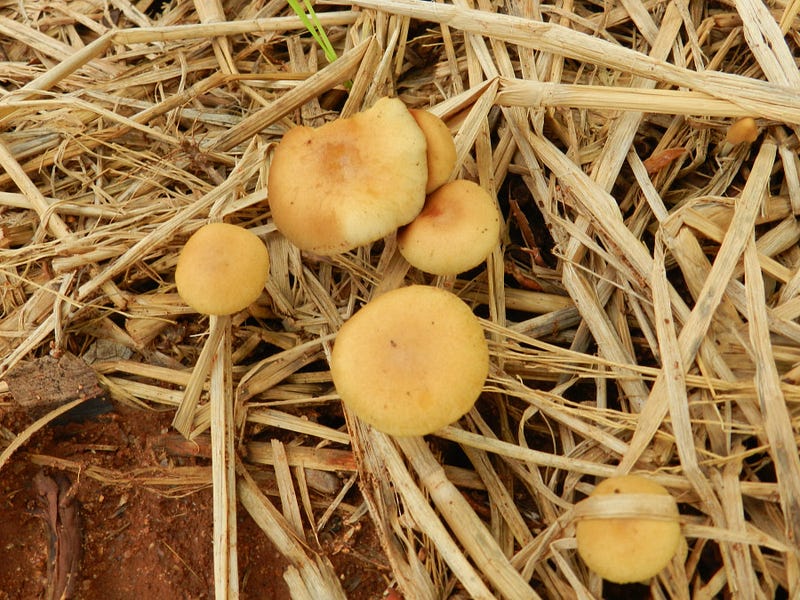
Here’s how it works.It takes six steps.
1. First, you start with soil. We identify what nutrition the soil lacks.
2. Then we identify what species we should be growing in this soil, depending on climate.
3. We then identify locally abundant biomass available in that region to give the soil whatever nourishment it needs. This is typically an agricultural or industrial byproduct - like chicken manure or press mud, a byproduct of sugar production - but it can be almost anything. We’ve made a rule that it must come from within 50 kilometers of the site, which means we have to be flexible.
4. Once we’ve amended the soil to a depth of one meter, we plant saplings that are up to 80 centimeters high, packing them in very densely - three to five saplings per square meter.
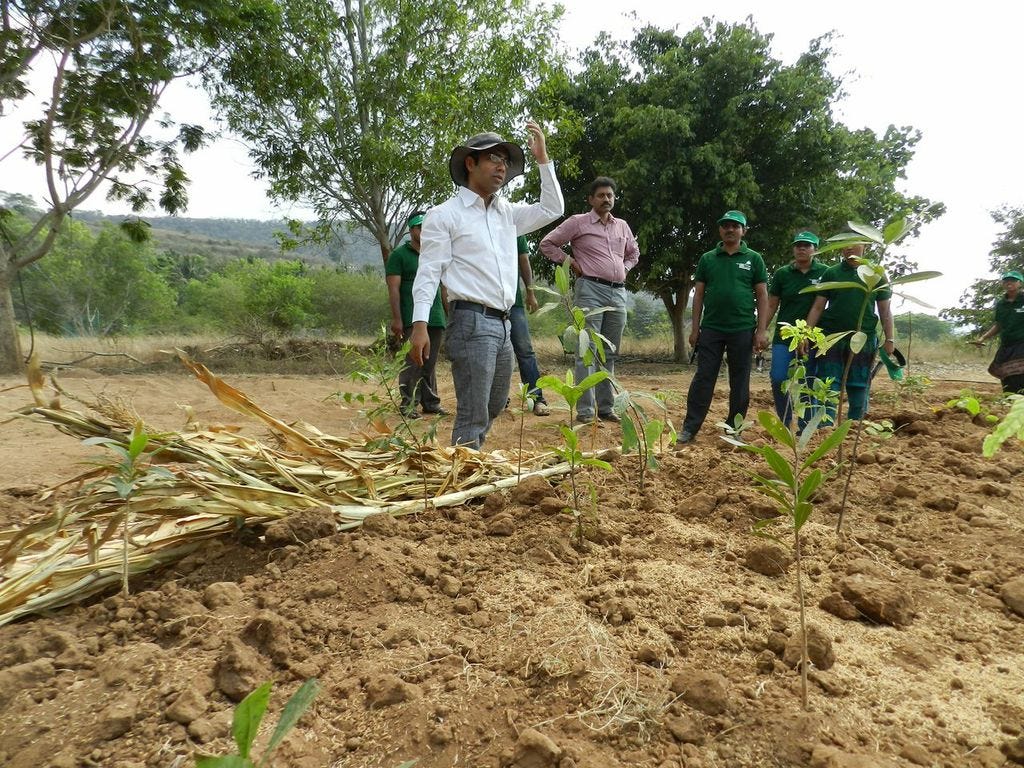
5. The forest itself must cover a 100-square-meter minimum area. This grows into a forest so dense that after eight months, sunlight can’t reach the ground. At this point, every drop of rain that falls is conserved, and every leaf that falls is converted into humus. The more the forest grows, the more it generates nutrients for itself, accelerating further growth. This density also means that individual trees begin competing for sunlight - another reason these forests grow so fast.
6. The forest needs to be watered and weeded for the first two or three years, at which point it becomes self-sustaining. After that, it’s best to disturb the forest as little as possible to allow its ecosystem, including animals, to become established.
Of course, you have to keep an eye on the forest in case of changing conditions. Rainfall patterns, for example, are different from what they were in the past, and that could affect native species. Oman, where I am doing a forestation project, is getting more rainfall year after year, so biodiversity is actually increasing. We’ve gone from having to plant thorny, bushy species that can grow in any desert to choosing more deciduous species.
This is why, for every species chosen, we do a thorough survey first. We go by real-time data, gathering information for our native species databases. So while a book on native trees may say that X, Y, Z species belongs to a particular geographic region, until we see that species grow full bloom and in good health in that region with our own eyes, we won’t select it as a forestation species.


Here’s the funny thing: I have no expertise about how to determine native species for forests! But I worked around this by applying car manufacturing models. At Toyota, I worked with the supplier development team, organizing assembly lines and dispatch systems for cars being manufactured in India. I applied these manufacturing principles to forests, developing a computer program that registers tree species’ specific parameters, such as how high it grows, in what months it blooms, the kinds of temperatures it can tolerate, and so on. For example, if there’s a species that grows up to 50 feet, the one planted next to it should grow only up to 20, because we don’t want a conflict after five years. In other words, we use car-assembly logic to pick an ideal combination of trees to best utilize vertical space. So it’s not me or any individual expert who decides what species to plant, at what ratios: the software figures it out.
We have to let each forest grow and see what can or can’t live in complete harmony with surrounding species. Those that die, we do not replace - that’s nature. It evolves by trial and error.
For water, we have a pattern requirement of how much water is required per square meter. For example, in India, it’s five liters per square meter. But we cannot predict with 100 percent accuracy the behavior of forests after five or ten years, because you can’t know what kind of bird species, predators, or pests are going to attack in time. We want 100 percent survival, but the survival rate we have is around 92 percent. That 8% percent gap is what we work to bridge. We aim to take our methodologies to such perfection that no trees will die. But it’s still a natural process; we have to let the forest grow and see what can or can’t live in complete harmony with surrounding species. Those that die, we do not replace - that’s nature. It evolves by trial and error.

One great thing about growing a forest is that you can eat it. The forest I grew in my backyard has 42 species of trees, of which 18 are fruit. Our guava trees produce so much fruit that we harvest at least five kilos a day. All my neighbors are getting guava nectar that my mother makes because we have such an abundance.
But not everyone wants a forest full of food - and forests aren’t necessarily good for producing single cash crops. A native forest has to be biodiverse to thrive - including a mix of at least 50 to 100 different species. So if market demand encourages farmers to nurture only fruit species, they will ignore the non-useful species, and the forest won’t survive.
Forests aren’t necessarily good for producing single cash crops. A native forest has to be biodiverse to thrive - including a mix of at least 50 to 100 different species.
At Afforestt, we grow four different types of forest. If I’m designing a forest for a corporate setting, the primary agenda will be aesthetics - a higher ratio of species with flowers, for instance. If I make a forest primarily for the sake of water conservation, the tree species should grow huge and have deep roots. In a public park, we’d choose species that grow small fruits to attract birds, appealing to park visitors. A forest on a farm would include more fruit species in the mix - up to half, including nuts, which offer high value as they can be preserved for a long time. Other useful trees for farming communities include those that produce oil seeds, fodder for cattle, or firewood for humans. So the combination depends on space and the priorities of the client.
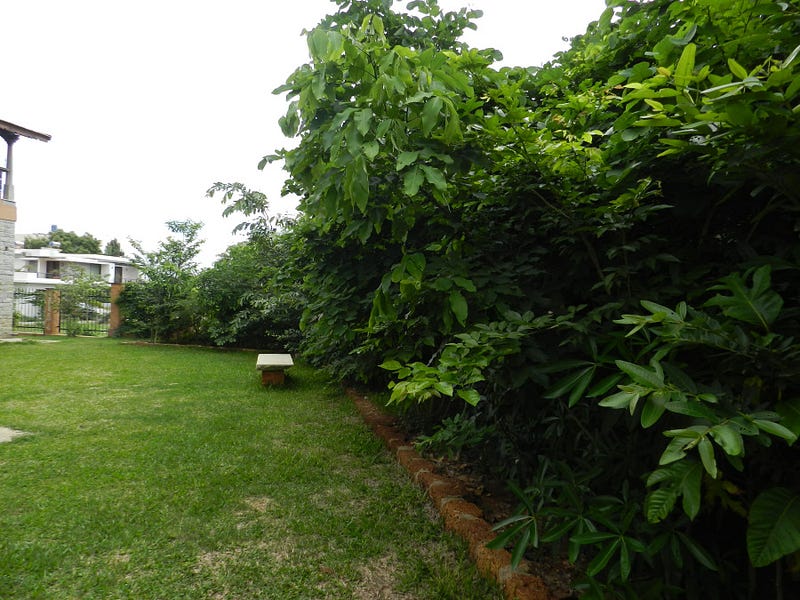

As for tangible environmental benefits, in my own garden, I’ve seen an increase from seven bird species to 17 in two years. I think if I were to do the same survey now, I’d find 20 species. Our groundwater used to disappear every summer, but the trees helped recharge our aquifer, so it returned after the second year, too. In cities, green areas improve air quality, increase biodiversity, and reduce the heat-island effect, which improves the microclimates of residential areas. Natural native forests are beneficial because they require no maintenance, in contrast to most urban landscaping, which is immensely resource-intensive, diminishing its ecological value. We also plant forests specifically to conserve groundwater tables.
I would love to partner with someone to conduct environmental studies and collect official data. It’s really expensive. There’s a specific scientific methodology to measure groundwater levels, for example.
So far, we’ve planted 43,000 trees for 33 clients. But our plan is to automate the system so that we can give anyone anywhere in the world step-by-step instructions on how to plant a native forest. We plan to crowdsource knowledge of native tree species; I’m working on a website for this part of the project and plan to launch it within a year. To make soil analysis easy for remote clients, we are also developing a small, GPS-enabled soil probe that will test soil and upload the data onto our server. When the probe is integrated with our database, at the push of a button you’ll know the soil constituents and what nutrients it needs, and we’ll be able to immediately send a complete species list and a detailed procedure.
In my backyard forest, I’ve seen an increase from seven bird species to 17 in two years… Our groundwater used to disappear every summer, but returned after the second year, too.
The hardware can be used to monitor the growth of this forest by reading how much sunlight is reaching the ground, changes in soil nutrition and moisture, and so on. We’ll launch five forest plantations in different places using this method, to prove that by using our methodology and following it step by step, anyone can make their own forest.
Once we’re able to share our afforestation methodology remotely, I believe we can increase scaling exponentially. Afforestt is a vehicle for offering afforestation methodology to people, but it’s the people who implement it who will make forestation scalable. Together, we can bring back entire lost forests.

One Person’s Trash Is Another’s Treasure: 10 Foods You Can Grow From Scraps

One of the biggest challenges to living off the grid in a sustainable way is figuring out what to do with your trash. It’s less a problem of disposal and more an issue of figuring out how to make use of everything you bring in. Making a compost heap is a great way to dispose of old food scraps and turn it into nutrient-rich soil. It takes your trash and turns it into a sort of black gold. But did you know you can regrow a lot of your food scraps?
What kind of foods can you regrow? Let’s run down the list.
1. Carrots.
Carrots are an easy one. Simply chop the tops of your carrots off, leaving about three quarters of an inch of the carrot still attached to the greens. Put in soil and water. A new carrot will grow out of the top.
2. Celery.
This was a good one for my household. We eat a ton of celery! Instead of throwing out the base of your celery, simply plant it in some decent soil and it’ll start regrowing almost immediately. Harvest it as you need it, and eventually you’ll never buy celery again.
3. Onions.
When you go to chop an onion, cut the roots off the bottom of the onion. Be sure to leave a little bit of the vegetable with the root. You don’t need much. Put the roots in soil, water frequently, and a new onion will grow out of it.
4. Green onions.
Like celery, simply plant the bases of your green onions in some soil and harvest as necessary. It will regrow rather quickly.
5. Romaine lettuce.
Leave a couple inches of leaf on the base of the plant and plant it in soil, just as you would celery or green onions.
6. Ginger.
This one isn’t exactly a food scrap, but you can break apart a ginger root and grow more ginger out of it. After about four months, you can re-harvest portions of the new root as you need it.
7. Pineapple.
Pineapple is one of the more difficult ones to regrow due to the length of time it takes and the fact that it only grows easily in some climates. But when you chop the top, leafy portion of the fruit off, plant it directly into some potting soil. A new pineapple will grow out of it.
8. Potatoes
One of my favorites. It’s so easy and you can yield a ton of potatoes out of just a few eyes. As they begin to grow eyes, or those little nodes you see coming out of the skin, chop them up, leaving a small cube of the potato with the eye itself. Plant a few inches apart in deeper soil. This one isn’t for small pots for sure.
9. Garlic.
Again, not exactly a food scrap, but you can take one bulb of garlic and, after fully grown, turn it into about a dozen. Simply break apart the bulb and plant in soil with the sprouted end up in the autumn. It may sound weird, but if you plant in the fall, it’ll begin growing early in the spring and you’ll have your harvest ready by late summer.
10. Mushrooms.
This is also a pretty difficult one to regrow, but it’s possible. Remove the head of the mushroom and plant the stalk in the soil with the very top of the stalk exposed to the air. A new mushroom head will grow out of the stalk if its kept in cool, moist areas without too much light.
Super Plant: Stinging Nettle
Super foods. They seem to be trending. So much about consuming these preciously nutritious products as part of our daily diets. Acai berries, quinoa, chia seeds, matcha, hemp seeds, raw cacao… It’s great that we are becoming more aware of the role good nutrition plays in our lives and that the accessibility of highly nutritious …
Cours Pratique de Design en Permaculture
La Permaculture La permaculture est un ensemble de pratiques et de modes de pensée visant à créer une production agricole durable, très économe en énergie et respectueuse des êtres vivants et de leurs relations réciproques. Elle vise à créer un écosystème productif en nourriture ainsi qu’en d’autres ressources utiles, tout en laissant à la nature …
Drums For Development is building InTerraTree!
Drums For Development inspires creative collaboration and empowers sustainable community development by connecting people through drumming. Updates: We have officially hit the $3,000 mark, meaning we can purchase the initial land in Togo! All remaining donations go directly towards growing food and digitally connecting the community with the world! Make a $20 donation to receive the Extended Version of …
6 Reasons Why Grass Lawns Suck
Grass lawns are another one of those things we just take for granted. Everyone has them, so why should we do differently? Turns out, there’s very few reasons to use grass as a lawn. Grasses are great at feeding grazing animals. This was their primary cultivated use throughout history. Afterwards, they became more of an …

